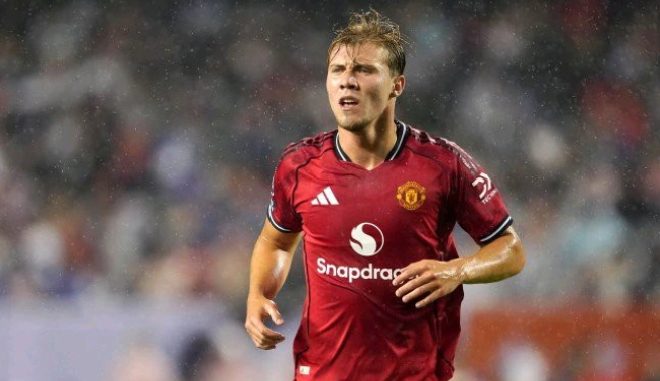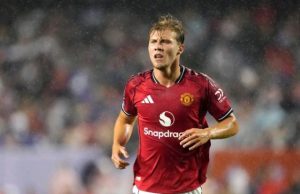
Manchester United Set Low Asking Price to Sell Rasmus Højlund After Benjamin Šeško Bid: Report
1. The Stage: United’s Striker Shake-Up
Manchester United find themselves deep in a summer of transition—and it may culminate in the surprising sale of Rasmus Højlund, their high‑profile £72 million striker signed from Atalanta in 2023. At just 22 years old, Højlund has struggled to make a lasting impact, and despite scoring in a recent pre‑season friendly against Bournemouth, his future is increasingly uncertain as the club targets Benjamin Šeško of RB Leipzig as the ideal No. 9 partner or potential successor.
—
2. The Numbers: Why the Low Price Tag?
Reports reveal United are prepared to accept just £30 million to move Højlund on—well below the £72 million they paid, representing a £42 million loss, and a hit of around £8.4 million in profit-and-loss terms. The decision appears to stem from a blend of financial pragmatism and sporting ambition:
Financial Fair Play pressure and the need to free up funds for a possible Šeško deal.
Impressive summer signings already made (e.g. Bryan Mbeumo, Matheus Cunha) pushing wage and amortization limits.
Højlund’s contract amortization value sits around £38.4 million, meaning selling for £30 m would reduce future wage burden (around £4.4m annually).
—
3. Højlund’s Position: Fight or Flight?
Despite transfer window rumors, Højlund has made it clear he hopes to stay and fight for his place. After scoring against Bournemouth, he reiterated: *“My plan is very clear… to stay and fight for my spot whatever happens.”* Manager Rúben Amorim echoed confidence in Højlund’s ongoing development and style of play, warning that no decisions are final until the market closes.
—
4. Šeško: The Target Driving It All
United’s reported pursuit of Slovenia’s rising star, Benjamin Šeško, is at the heart of the speculation. The forward is valued at around €70 million (≈£60m)—Leipzig seem determined to hold out for that price despite Newcastle submitting a bid. Šeško apparently holds a release clause in the region of €50m that could provide value, and United seem to believe he’d form a promising partnership alongside Højlund.
Højlund himself has not accepted being part of a potential swap deal with Šeško—opting instead to stay solely focused on competition at Old Trafford.
—
5. Performance Review: Why the Sale?
2023–24 season: A bright introduction with 16 goals in 43 appearances and a Player of the Month award—but inconsistent form followed.
2024–25 season: A slump to just 4 Premier League goals in 32 games, followed by pundit criticism and a lengthy goalless run.
While he ended the season with a goal vs Leicester to break the drought, the consistency lacked.
In contrast, Šeško brings recent form, scoring regularly in Bundesliga and exhibiting strong finishing potential. United view the Slovenian as a younger, high-ceiling alternative.
—
6. Tactical Fit & Philosophy
Under Amorim’s 3‑4‑2‑1 system, United have leaned heavily on high-pressing, quick link-up play between midfield and attack. While Højlund fits that model to some extent, United have sought a striking partner or replacement in Šeško who they believe offers more synergy in pace, dribbling, and pressing intensity.
Sir Jim Ratcliffe’s growing influence on both finances and football operations underscores the shift toward younger, more adaptable acquisitions. The sale of Højlund for significant loss—but long-term wage savings—aligns with this strategy.
—
7. What Happens Next?
If Højlund leaves:
United could recoup funds to pursue Šeško or even Ollie Watkins of Aston Villa, who is also under consideration. Watkins’ Premier League experience makes him appealing, though Villa say he is not available.
The move would signal a clear shift in attacking strategy and Freshment of the squad.
If Højlund stays:
He’ll continue to compete with new signings for minutes—maintaining strong fitness and scoring more may shift Amorim’s mind.
Šeško still could arrive, with Højlund offering competition or rotation options.
The key determinant now hinges on Šeško’s decision: will he signal clear interest in joining United? Newcastle made a firm offer rejected by Leipzig; United are reportedly waiting for Šeško’s preference before making a formal bid.
—
8. Broader Club Implications
For United’s business model: Accepting a large financial hit signals a willingness to reset priorities around long‑term squad sustainability, wage control, and value acquisitions.
Psychological message: Players like Garnacho, Anthony, Sancho, and perhaps Rashford may see this as a signal—performance and attitude count if the club is reshaping its attacking hierarchy.
Fan perspective: Some will view the sale as harsh, given the price-tag initially paid; others may welcome the move as necessary for progress if Šeško or Watkins arrive and elevate United’s goalscoring output.
—
9. Conclusion: A Transitional Window
Manchester United appear to be at a crossroads: sticking with Højlund despite underwhelming numbers or cutting losses to pursue what they see as greater strategic upside in a forward like Šeško. With financial realities, manager strategy, and player ambition interwoven, the decision underscores a club looking to reset its identity up front.
Should the £30 million exit materialize, it would not just mark a low point in Højlund’s short Old Trafford career, but set in motion a potential reshuffling of United’s strike options—a risky but potentially rewarding gamble.

Leave a Reply